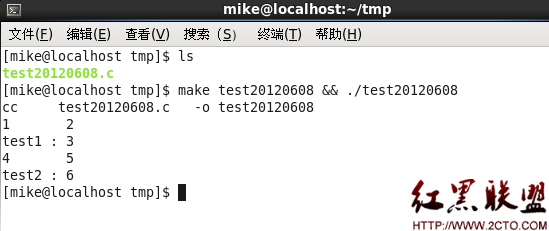最近在看Asterisk的源代碼,收獲不小,決定記錄下來學習Asterisk過程中的點滴,分享給大家,也方便我以後查閱……
今天讓我感到意外的是Asterisk中對結構體初始化(或者說成是賦值)的使用。
比如定義結構體如下:
typedef struct ST {
int a;
int b;
pFun fun;
}ST;
一般的初始化是這樣的:
ST t2;
t2.a=4;
t2.b=5;
t2.fun=test2;
而我在源碼中看到的是這樣的:
ST t1 = {.a=1,.b=2,.fun=test1};
感覺好強大。。。。。。
這裡是我仿照著寫的完整代碼:
1 #include <stdio.h>
2
3 typedef void (*pFun)(int a);
4
5 typedef struct ST {
6 int a;
7 int b;
8 pFun fun;
9 }ST;
10
11 void test1(int a)
12 {
13 printf("test1 : %d\r\n",a);
14 }
15
16 void test2(int a)
17 {
18 printf("test2 : %d\r\n",a);
19 }
20
21 int main()
22 {
23 ST t1 = {
24 .a=1,
25 .b=2,
26 .fun=test1
27 };
28
29 printf("%d\t%d\n",t1.a,t1.b);
30 t1.fun(3);
31
32 ST t2;
33 t2.a=4;
34 t2.b=5;
35 t2.fun=test2;
36
37 printf("%d\t%d\n",t2.a,t2.b);
38 t2.fun(6);
39
40 return 0;
41 }
這裡存盤為test20120608.c,進行如下操作:
make test20120608 && ./test20120608
測試結果:

摘自 MikeZhang的博客